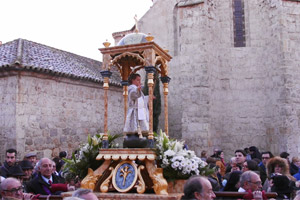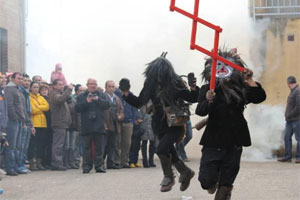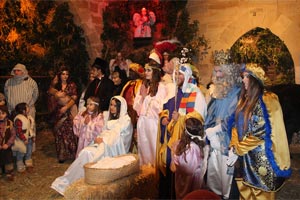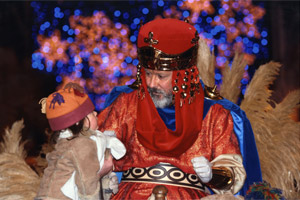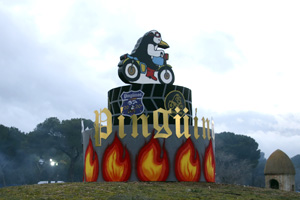The Painted Eggs of Pola de Siero
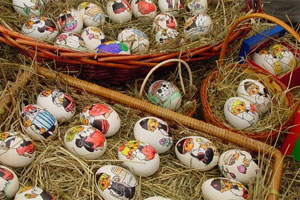
What the festival consists of
The festival celebrated in La Pola Siero, Asturias, consists of the exhibition, sale, and gifting of hand-painted eggs. It takes place on the Tuesday following Easter Sunday and features stalls adorned with painted eggs of different sizes and decorations, many of which include motifs alluding to traditional Asturian culture and phrases and symbols in vibrant colors.
Since 1968, this festival has been declared of National Touristic Interest and features activities beyond the exhibition of eggs. Asturian gastronomy and folklore also play an important role in the festival, with cider, snacks, songs, and dances. The Blessing of the Painted Eggs in the town hall square marks a very special moment in the celebration.
Visitors can enjoy the lively atmosphere of the celebration while trying Asturian specialties such as cider, cheese, and cured meats. Additionally, there are parades and traditional Asturian music to complete the experience. The festival culminates with a party that lasts until the early hours of the morning. This festival is also celebrated in Sama.
Origins
The tradition of painting and decorating eggs, known as Huevos Pintos, has a long history and an uncertain origin dating back several centuries, at least to the 17th century. It has been passed down orally from generation to generation and is believed to be related to the arrival of Central European workers in the area's mines.
According to the most accepted theory, the tradition of giving painted eggs has to do with Lent and the prohibition of consuming certain foods, including eggs. In this way, they were accumulated in homes where there were chickens, and at the end of Lent, the idea of giving them as gifts to family and friends became popular. The custom of enriching and decorating the eggs could have originated in the court and later been adopted by the general population.
It is also related to possible religious roots or other traditions. In addition, the tradition of decorating eggs is found in several European countries, such as France, Russia, England, Germany, Greece, and various Spanish regions.
This tradition could be associated with the arrival of spring and honoring the fertility and rebirth of nature, practices that date back to pre-Christian times and have endured over time. In short, the tradition of Huevos Pintos is a rich and diverse cultural expression that has been passed down from generation to generation and continues to be celebrated in other parts of the world.
How to paint the eggs
The technique for making a "huevo pinto" can vary, but generally, first the egg is boiled and the design is drawn on while it is still hot so that the color can "stick". Then the color is applied, which can be Chinese ink, watercolor, dye, or other materials, and they are varnished so that the color lasts. In La Pola, Asturias, they have developed a clear technique for painting eggs, which can take several weeks and hours of work per day.
In the past, the designs drawn on the eggs were mainly traditional, with typically Asturian scenes. But over time, the variety of motifs has expanded and now painted eggs can be found with reproductions of famous works of art, characters from children's series, regional and universal symbols, brands and logos, and much more. Some people use techniques like the Pysanky style, which uses beeswax and natural dyes, while others use more modern techniques like Chinese ink, watercolor, oil, and gum arabic.
In addition, many painted eggs include a legend, poem, or witty phrase on the back, giving them an additional dimension and aspirations beyond simply being a decoration. Painted eggs are true works of art, seeking to make us laugh, chat, think, and even reflect.
Link with a pilgrimage
The Romería de los Huevos Pintos is an ancient festival celebrated in Siero, Asturias. This tradition was already famous in the 18th century, and at that time, the king granted a regulation authorizing the municipality to spend a large amount of money to finance the festivals, both religious and secular, associated with the pilgrimage.
In a chronicle from 1860, written by Protasio Sánchez Solís, the animation and the large number of horse-drawn carriages that came to the pilgrimage from Oviedo and Gijón are described. At that time, the eggs were boiled in the old Asturian kitchens and painted with soot, which gave them the nickname "huevos prietos" (dirty eggs). Over time, the inhabitants of Siero discovered the dyeing of eggs with anilines, which allowed them to be decorated with names, dedications, verses, coats of arms, and flowers. For this, sticks wetted in nitric acid were used to write and draw on the eggs. Since then, the festival changed its name from "Huevos Prietos" to "Huevos Pintos" (painted eggs).
What to see in Pola de Siero
Pola de Siero is a beautiful Asturian city that offers many interesting tourist attractions. Some of the things you could see and do in Pola de Siero include:
- Evaristo Valle Museum: A modern art museum that houses a large collection of works by local artist Evaristo Valle.
- San Pedro Church: This 13th-century church is a good example of Asturian Romanesque style and houses some important works of art.
- Covered Square: The center of Pola de Siero is the Covered Square, which is a lively place with many shops, bars, and restaurants.
- Prehistoric Park: A theme park that shows the life of prehistoric humans through exhibitions and interactive activities.
- Romería de los Huevos Pintos: As mentioned above, this tradition is celebrated in the city and is a unique opportunity to see the famous painted eggs of the area.
- Nature walks: Pola de Siero is surrounded by beautiful natural landscapes, so there are many opportunities for hiking, cycling, or simply enjoying the beauty of the Asturian countryside.
- Weekly market: On Saturday mornings, a weekly market is held in the city where local products such as fruits, vegetables, cheeses, sausages, and crafts can be purchased.
What to eat in Pola de Siero
In Pola de Siero and in Asturias in general, there is a wide variety of typical dishes and local products that are worth trying. Some of the most popular dishes are:
- Fabada Asturiana: a stew of white beans, chorizo, blood sausage, bacon, and pork belly, considered one of the most typical dishes of Asturias.
- Cachopo: a dish made up of two beef fillets stuffed with serrano ham and cheese, breaded and fried.
- Cider: Asturian cider is very popular and is served in cider houses, where it is poured from a bottle raised above the head so that it falls into a glass held by the diner.
- Asturian cheeses: there is a wide variety of local cheeses, such as Cabrales cheese, Afuega'l pitu cheese, and Gamonéu cheese.
- Rice pudding: a typical Asturian dessert made with rice, milk, sugar, and cinnamon.
In addition to these dishes, in Pola de Siero and in Asturias, other local products can be found, such as sausages, seafood, vegetables, fruits, honey, and traditional sweets.

